从文化角度看习语翻译
- 格式:docx
- 大小:34.29 KB
- 文档页数:15

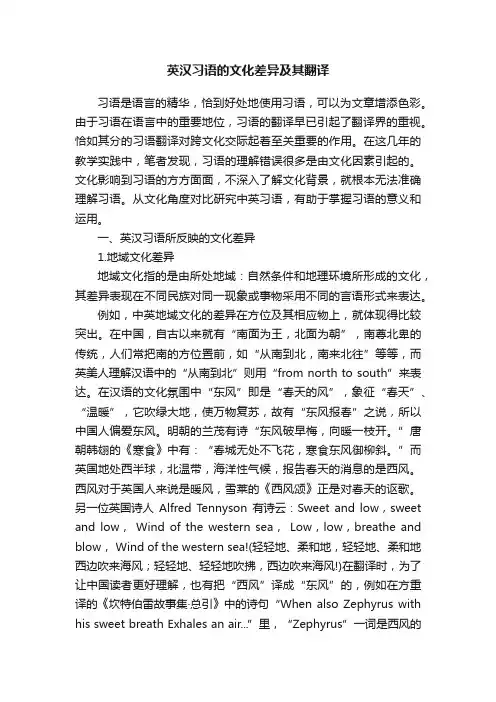
英汉习语的文化差异及其翻译习语是语言的精华,恰到好处地使用习语,可以为文章增添色彩。
由于习语在语言中的重要地位,习语的翻译早已引起了翻译界的重视。
恰如其分的习语翻译对跨文化交际起着至关重要的作用。
在这几年的教学实践中,笔者发现,习语的理解错误很多是由文化因素引起的。
文化影响到习语的方方面面,不深入了解文化背景,就根本无法准确理解习语。
从文化角度对比研究中英习语,有助于掌握习语的意义和运用。
一、英汉习语所反映的文化差异1.地域文化差异地域文化指的是由所处地域:自然条件和地理环境所形成的文化,其差异表现在不同民族对同一现象或事物采用不同的言语形式来表达。
例如,中英地域文化的差异在方位及其相应物上,就体现得比较突出。
在中国,自古以来就有“南面为王,北面为朝”,南尊北卑的传统,人们常把南的方位置前,如“从南到北,南来北往”等等,而英美人理解汉语中的“从南到北”则用“from north to south”来表达。
在汉语的文化氛围中“东风”即是“春天的风”,象征“春天”、“温暖”,它吹绿大地,使万物复苏,故有“东风报春”之说,所以中国人偏爱东风。
明朝的兰茂有诗“东风破早梅,向暖一枝开。
”唐朝韩翃的《寒食》中有:“春城无处不飞花,寒食东风御柳斜。
”而英国地处西半球,北温带,海洋性气候,报告春天的消息的是西风。
西风对于英国人来说是暖风,雪莱的《西风颂》正是对春天的讴歌。
另一位英国诗人Alfred Tennyson有诗云:Sweet and low,sweet and low,Wind of the western sea,Low,low,breathe and blow, Wind of the western sea!(轻轻地、柔和地,轻轻地、柔和地西边吹来海风;轻轻地、轻轻地吹拂,西边吹来海风!)在翻译时,为了让中国读者更好理解,也有把“西风”译成“东风”的,例如在方重译的《坎特伯雷故事集·总引》中的诗句“When also Zephyrus with his sweet breath Exhales an air...”里,“Zephyrus”一词是西风的意思,而译文则是“当东风吹香……”。
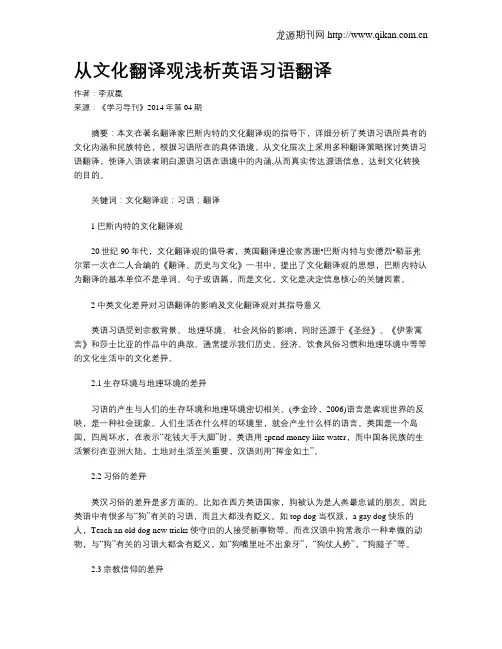
从文化翻译观浅析英语习语翻译作者:李双赢来源:《学习导刊》2014年第04期摘要:本文在著名翻译家巴斯内特的文化翻译观的指导下,详细分析了英语习语所具有的文化内涵和民族特色,根据习语所在的具体语境,从文化层次上采用多种翻译策略探讨英语习语翻译,使译入语读者明白源语习语在语境中的内涵,从而真实传达源语信息,达到文化转换的目的。
关键词:文化翻译观;习语;翻译1巴斯内特的文化翻译观20世纪90年代,文化翻译观的倡导者,英国翻译理论家苏珊•巴斯内特与安德烈•勒菲弗尔第一次在二人合编的《翻译、历史与文化》一书中,提出了文化翻译观的思想,巴斯内特认为翻译的基本单位不是单词、句子或语篇,而是文化,文化是决定信息核心的关键因素。
2中英文化差异对习语翻译的影响及文化翻译观对其指导意义英语习语受到宗教背景、地理环境、社会风俗的影响,同时还源于《圣经》、《伊索寓言》和莎士比亚的作品中的典故。
通常提示我们历史、经济、饮食风俗习惯和地理环境中等等的文化生活中的文化差异。
2.1生存环境与地理环境的差异习语的产生与人们的生存环境和地理环境密切相关。
(李金玲,2006)语言是客观世界的反映,是一种社会现象。
人们生活在什么样的环境里,就会产生什么样的语言。
英国是一个岛国,四周环水,在表示“花钱大手大脚”时,英语用spend money like water,而中国各民族的生活繁衍在亚洲大陆,土地对生活至关重要,汉语则用“挥金如土”。
2.2习俗的差异英汉习俗的差异是多方面的。
比如在西方英语国家,狗被认为是人类最忠诚的朋友。
因此英语中有很多与“狗”有关的习语,而且大都没有贬义。
如 top dog 当权派,a gay dog快乐的人,Teach an old dog new tricks使守旧的人接受新事物等。
而在汉语中狗常表示一种卑微的动物,与“狗”有关的习语大都含有贬义,如“狗嘴里吐不出象牙”,“狗仗人势”,“狗腿子”等。
2.3宗教信仰的差异源自宗教信仰的习语也大量出现在英汉两种语言中。

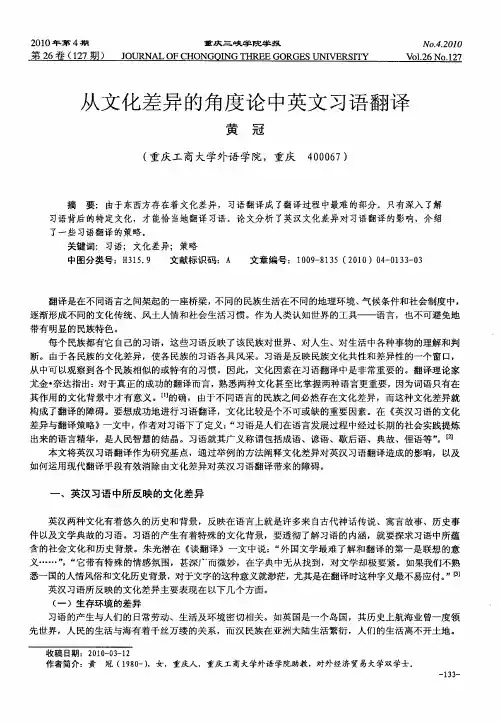
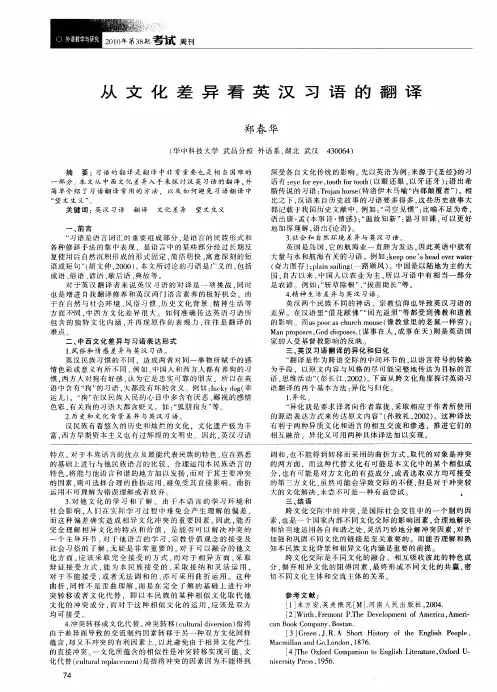
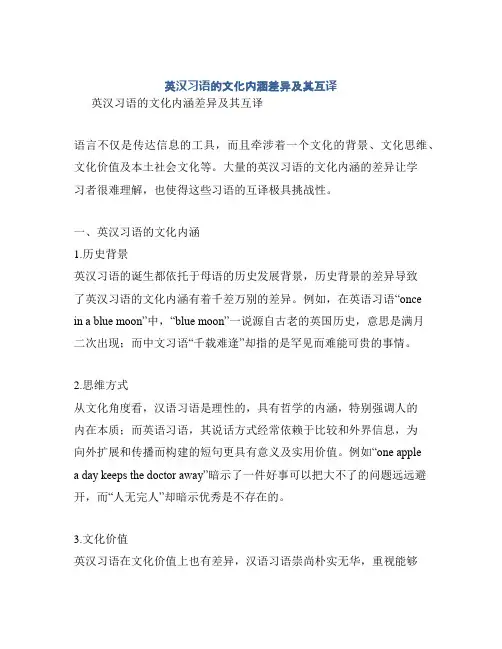
英汉习语的文化内涵差异及其互译英汉习语的文化内涵差异及其互译语言不仅是传达信息的工具,而且牵涉着一个文化的背景、文化思维、文化价值及本土社会文化等。
大量的英汉习语的文化内涵的差异让学习者很难理解,也使得这些习语的互译极具挑战性。
一、英汉习语的文化内涵1.历史背景英汉习语的诞生都依托于母语的历史发展背景,历史背景的差异导致了英汉习语的文化内涵有着千差万别的差异。
例如,在英语习语“oncein a blue moon”中,“blue moon”一说源自古老的英国历史,意思是满月二次出现;而中文习语“千载难逢”却指的是罕见而难能可贵的事情。
2.思维方式从文化角度看,汉语习语是理性的,具有哲学的内涵,特别强调人的内在本质;而英语习语,其说话方式经常依赖于比较和外界信息,为向外扩展和传播而构建的短句更具有意义及实用价值。
例如“one applea day keeps the doctor away”暗示了一件好事可以把大不了的问题远远避开,而“人无完人”却暗示优秀是不存在的。
3.文化价值英汉习语在文化价值上也有差异,汉语习语崇尚朴实无华,重视能够磨练心智的思考和行为;而英语习语则崇尚高尚的文明,强调坚持原则,如“no pain no gain(不努力没有收获)”。
二、英汉习语的互译由于英汉习语的文化内涵差异,仅通过翻译不能完全表达原有的内涵和意义,这就导致英汉习语的互译很容易出现问题。
1.词义辨析单纯以词义辨析为准,很容易翻译错误。
例如,英语中的“apple”既指苹果又指英国的“苹果公司”,而中文中的“苹果”则只指吃的水果,并不能翻译成“Apple”。
2.文化差异由于文化差异,原有的文化背景意义很容易丢失,也影响了英汉习语的可操作性。
例如,英语中的“red tape”指的是政府官僚作风,表现在中文中就变成了“繁文缛节”;另外,英语习语“pig in a poke”源自旧时西洋猪拳,中文则变成“买老虎铁笼”,并多带着贬义。
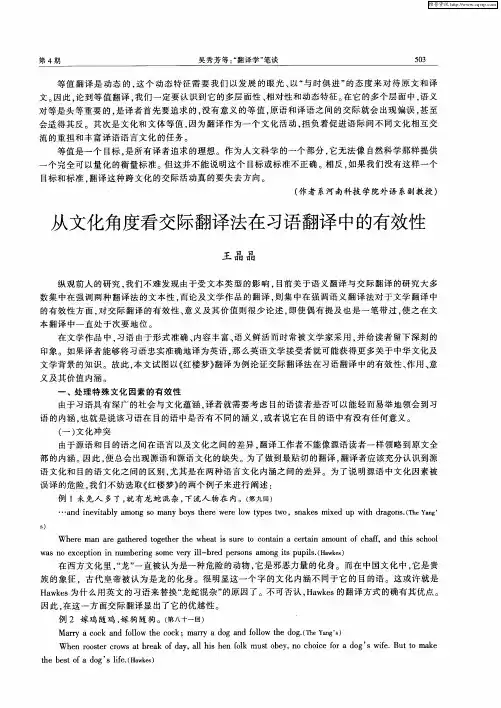
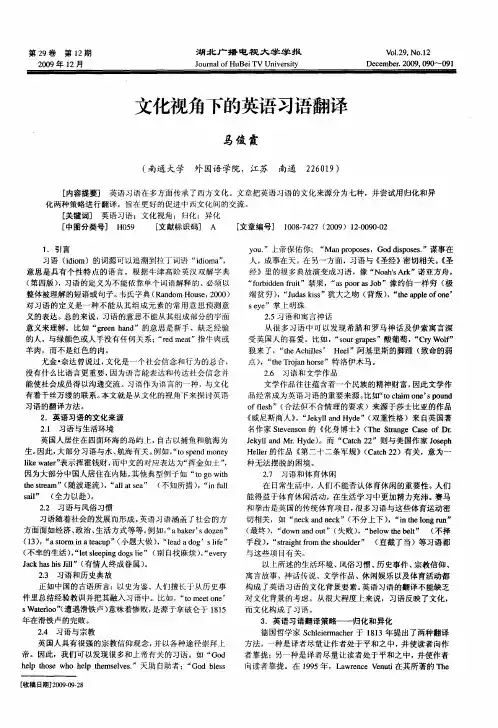
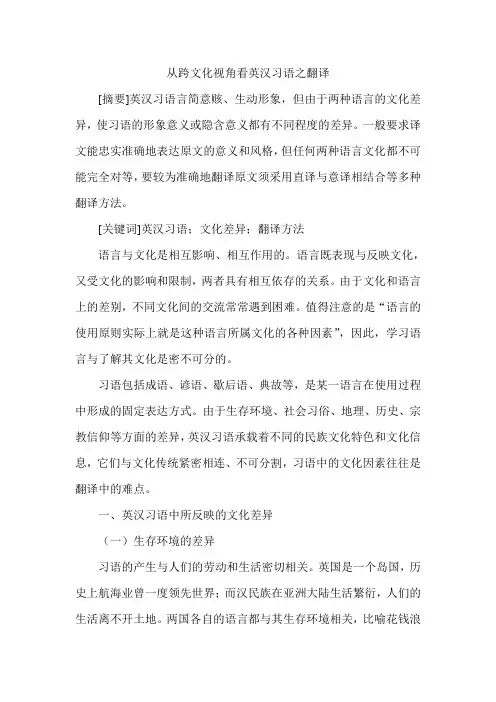
从跨文化视角看英汉习语之翻译[摘要]英汉习语言简意赅、生动形象,但由于两种语言的文化差异,使习语的形象意义或隐含意义都有不同程度的差异。
一般要求译文能忠实准确地表达原文的意义和风格,但任何两种语言文化都不可能完全对等,要较为准确地翻译原文须采用直译与意译相结合等多种翻译方法。
[关键词]英汉习语;文化差异;翻译方法语言与文化是相互影响、相互作用的。
语言既表现与反映文化,又受文化的影响和限制,两者具有相互依存的关系。
由于文化和语言上的差别,不同文化间的交流常常遇到困难。
值得注意的是“语言的使用原则实际上就是这种语言所属文化的各种因素”,因此,学习语言与了解其文化是密不可分的。
习语包括成语、谚语、歇后语、典故等,是某一语言在使用过程中形成的固定表达方式。
由于生存环境、社会习俗、地理、历史、宗教信仰等方面的差异,英汉习语承载着不同的民族文化特色和文化信息,它们与文化传统紧密相连、不可分割,习语中的文化因素往往是翻译中的难点。
一、英汉习语中所反映的文化差异(一)生存环境的差异习语的产生与人们的劳动和生活密切相关。
英国是一个岛国,历史上航海业曾一度领先世界;而汉民族在亚洲大陆生活繁衍,人们的生活离不开土地。
两国各自的语言都与其生存环境相关,比喻花钱浪费,大手大脚,英语是spend money like water,而汉语是“挥金如土”。
英语中有许多关于船和水的习语,在汉语中没有完全相对应的习语,如to hold water(指辩论、接口、理论等经得起检验的,站得住脚的),between the devil and the deep blue sea(进退维谷,左右为难)等等。
在汉语的文化氛围中,东风是“春天的风”,而east wind(东风)在英国是从北冰洋刮来的刺骨寒风,给英国民族带来不好的心理反应。
因此在翻译“东风”时我们应附加一些信息作为脚注,这样英国人才不会对这个词有心理上的错解了。
英国地处西半球,北温带,海洋性气候,这里报告春天消息的是西风,西风对于英国人是暖风,是生命的催生剂。

从文化差异的角度看英汉习语的翻译摘要: 习语是某一语言在使用过程中形成的独特的固定的表达方式, 最能体现一个民族的文化。
翻译与文化密切相关。
从英汉习语的文化的表现, 提出了英汉习语文化意义的翻译原则和方法。
关键词: 文化差异; 习语; 文化含义; 翻译Abstract : Idiom is a specific and structurally fixed expression in a certain language. It is formed while the language is being used. Itis one of the most important ways to show a nations’culture. Translation is intimately related to culture. This paper mainly discussesthe cultural difference between English and Chinese , which is reflected in idioms. It also brings up the principles and ways to translateEnglish and Chinese idioms.Key words : cultural difference ; idiom; cultural meaning ; translation什么叫文化? 根据《辞海》的解释, 文化是指人类社会历史过程中所创造的物质财富和精神财富的总和。
有“现代文化之父”之称的美国人类学家克鲁克洪对文化的定义是“文化是历史上所创造的生存式样的系统, 既包括显形式样又包括隐形式样, 它具有整个群体共享的倾向, 或是在一定时期中为群体的特定部分所共享的”。
习语是某种语言在使用过程中形成的独特的固定的表达方式。
从文化角度看英汉习语翻译Idioms Translation from Cultural PerspectivesAbstractAlong with the development of the communications between the East and the West, translation becomes more and more important, of which idiom translation takes a great position. Idioms are the fruits of human culture, which reflect the culture in return. It is a big concept, which contains set phrases, sayings, proverbs, slangs, colloquialisms and enigmatic folk similes. Idioms come from various sources, such as from history, religion, poetry, literary quotations, daily life, etc. It is the point that idiom covers a rich information of its society and culture that makes the translation much more difficult than that of others, for it requires a better grasp of both the techniques of translation and the knowledge of the background of its target language, including its culture, history, religion, society, etc.With a view to having a better master of idioms translation, in this thesis I will talk about the techniques of idiom translation from the cultural perspective by the means of comparing the Chinese and English images.This thesis indicates the significance and the present situation of idioms translation, gives a brief introduction of idiom, including the definitions, formations, categories and the significance, makes a contrast between Chinese and English idioms’ images, introduces the techniques of idioms translation on the basis of the comparison, andconcludes the whole thesis and points out the limitation of this thesis and gives several suggestions for further studies.Key words: idioms; idiom translation; culture; technique摘要随着中西方文化交流的深化和进展,两边语言翻译变的愈来愈重要了,而其中习语的翻译更是占了一个相当大的比重,有着举足轻重的作用。
论文化差异视角下的英汉习语翻译随着全球化和跨文化交流的不断加深,翻译作为一种跨文化交流手段,变得越来越重要。
无论是商业、文学还是科技领域,翻译都扮演着重要的角色。
英汉习语是两种语言中不可或缺的元素之一。
然而,在进行英汉习语翻译时,由于文化差异,译者需要考虑许多因素。
本文将探讨论文化差异视角下的英汉习语翻译。
首先,我们需要了解习语的定义和特点。
习语是一种固定化的语言形式,其意义和字面意思不一样,通常包含隐喻和比喻。
换句话说,习语不是直接的文字组合,而是人们在日常交流中形成的约定俗成的表达方式。
英汉习语有许多相似之处,比如“大海捞针”和“looking for needle in a haystack”,两者都表示非常困难的事情。
但是,两种语言中的习语也存在许多文化差异。
例如,“猫哭耗子”在汉语中表示水深火热的情况下仍然无动于衷,而在英语中,“when the cat is away, the mice will play”表示没有监管时人们会做坏事。
由于这种文化差异,进行英汉习语翻译需要考虑多个方面。
首先是语言差异。
英语习语通常是句子,而汉语习语则通常是四个字或者八个字的成语。
这些不同的长度和形式都需要考虑到翻译中。
此外,还需要考虑到语境和文化差异。
某些英语习语可能在中国文化中没有体现,或者需要用中国文化中的特定习语来翻译。
除了这些语言和文化差异,翻译者还需要考虑翻译目的。
是要保留源语习语的味道,还是为了跨文化交流而进行本地化?这些问题也需要看情况进行选择。
在进行英汉习语翻译时,我们不能只关注文字本身,还需要了解文化背景和使用场景。
只有这样才能准确、自然地进行翻译。
作为翻译者,我们需要学习不同语言和文化之间的差异,并且不断提高自己的语言水平和跨文化交流能力。
总结来说,英汉习语翻译是一项需要细心、耐心、甚至文化素养的工作。
只有在充分了解语言和文化差异的基础上,才能进行准确、自然和有效的翻译。
从文化语境的角度看英汉习语翻译
吴军赞
【期刊名称】《西华师范大学学报(哲学社会科学版)》
【年(卷),期】2006(000)005
【摘要】本文阐述了语境及文化语境的内涵,认为对文化语境的把握和理解是英汉习语翻译成败的关键,在此基础上,作者进一步提出了英汉习语翻译的对策.
【总页数】4页(P126-129)
【作者】吴军赞
【作者单位】四川农业大学外语系,四川,雅安,625014
【正文语种】中文
【中图分类】H3
【相关文献】
1.从文化角度看英汉习语翻译 [J], 雷淇婷;
2.从文化角度看英汉习语翻译的差异 [J], 于霞;
3.从文化角度看英汉习语翻译的差异 [J], 于霞
4.谈英汉文化语境差异对英汉习语翻译的影响 [J], 高国庆
5.文化语境顺应视角下的英汉动物习语翻译分析 [J], 陆阳;张荣萍;
因版权原因,仅展示原文概要,查看原文内容请购买。
从文化角度看习语翻译【摘要】习语是语言文化的结晶,缺少了习语,语言将会变得索然无味。
习语在语言中的应用比比皆是,在写作或演说中适当地使用习语将会使篇章增色,加强语言的力量使语言更形象。
奈达曾说过,习语是比任何非习语更具冲击力的表达,它带有一种语言和文化的识别特征。
习语被广泛应用于各类写作和演说中,如在文学作品中,在科学著作中,在政治演说中,甚至在美国,习语都成为辩论中唇枪舌战的武器。
美国第16届总统亚伯拉罕·林肯在他一篇著名演说中引用了圣经里的一句话:“互相分裂的房子无法站立。
”来号召美国人民团结一致反对黑奴制度,停止战。
美国人对圣经的容都很熟悉,他们为此深受感动。
林肯废奴运动也取得了很好的结果。
既然习语在语言运用中有如此重要地位,那么恰到好处地翻译习语将有助于跨文化交流。
中英不同的文化使得英汉习语在表达上有很大差异,也使得翻译中容易产生误译,因此加强对英汉习语文化涵差异的了解有着重要意义。
本文在探讨英汉习语文化涵差异的基础上提出了四种翻译方法:直译法、意译法、意象转移法、增删法。
【关键词】习语;文化;习语翻译【Abstract】 Idioms, having universal appeal, are widely recognized as the essence or the crystallization of language. Without idioms language would become dull and dry, whereas an appropriate use of them in speech and writing will add much to variety strength and vividness of the language. Idioms usually carry more impact than none-idiomatic expressions because of their close identification with a particular language and culture. Idioms are widely used in almost all kinds of speeches and writings: they can be found in literary works, in scientific and political articles; even debates in the United Nations are often interspersed with idioms which become verbal weapons that are difficult to argue against. The 16th US President Abraham Lincoln once quoted an idiom derived from the Bible: “A house divided against itself cannot stand.” in one of his famous speech, calling o n people to fight against slavery and Civil War. American people, who were familiar with the Bible, were greatly impressed and Lincoln’s antislavery campaign at last yielded fruitful result. Thus idioms hold an important position in language use, an adequate translation of idioms is not only helpful but also essential in intercultural communication.This paper attempts to make a brief comparative study of the cultures embodied in Chinese and English idioms and explores the role of the culture in understanding and rendering of both English and Chinese idioms.【Key Words】 Idioms; culture; the translation of idioms1. IntroductionCultural studies have currently been prevailing in the west. And talking about cultural studies has also become a fashion in the circle of present Chinese culture and academia, especially in the field of literary theory and criticism. Accordingly,in the wide sphere of translation studies, there are some scholars both at home and abroad who have tried to replace translation with cultural translation studies and interpretation. Translation is considered to be a cross-cultural communication, which concerns not only the transfer between languages, but also the transfer between cultures. However, the ways of thinking, beliefs, attitudes and values of different cultures not only give rise to failures or misunderstandings in cross-cultural communication but also pose headaches to translation theorists and translators. An idiom is a beautiful gem of a language as well as crystallization of national culture. Yet it is also one of the most difficult things to learn and use in a foreign language. They are often rather hard to understand from the meaning of individual words. Chinese and English both abound with idioms, whose succinct forms and profound meanings make themselves more condensed and expressive. Many idioms bear figures and strong cultural flavors. If they are translated appropriately, not only can the original spirit and meanings be faithfully conveyed, clearly understood and accepted by the target language readers, but also the Chinese and English vocabularies can be enriched to provide a broader cultural vision. The issues of rendering idioms of one language into another are always complicated, if the two languages involved are so unlike in backgrounds and cultures with each other. This paper expounds the close relationship between idioms and culture translation, and the issue of idiom translation is explored from a cultural perspective.2. Definitions and forms of idiom2.1 The definitions of idiomThe word “idiom” possesses several meanings. It may be defined as “the language of a people or a country”, as in “the Chinese idiom”; or “a dialect” as in “Cantonese idiom”. It may also be defined, according to Oxford Advanced Learner’s E nglish-Chinese Dictionary, as “phrase or sentence whose meaning is not clear from the meaning of its individual words and which must be learnt as a whole unit”[1] p734. The second definition most suits the purpose of this paper. The Chinese “equivalent” for“ idiom” is“习语”, it also refers to a kind of a set phrase or sentence fixed by long usage. From the above definitions we can extract two basic criteria on which to decide whether or not an expression is an idiom(or:习语):Firstly, established and refined by long practical use, an idiom has a relatively high degree of stability of the lexical components. An idiom allows little or no variation in form under normal circumstances. In general, any change in the components will result in absurdities or even render the idioms meaningless. A speaker or writer cannot normally do any of the following with an idiom unless he or she is consciously making a joke or attempting play on words:a. Change the order of the words in it (e.g.* “at sevens and sixes” instead of “at sixes and sevens”);b. Delete a word from it (e.g.* “a kettle of fish” instead of “a nice kettle offish”);c. Add a word to it (e.g.* “to show one’s white teeth” instead of “to show one’s teeth”);d. Replace a word with another (even with a synonymous wo rd) (e.g.* “the pear of one’s eye ” instead of “the apple of one’s eye”)e. Change its grammatical structure (e.g.* “a king may be looked at by a cat” instead of “a cat may look at a king”).Similarly in Chinese we can only say: “七零八落” not “八零七落;”“无的放矢”no t “无的放箭”, although “矢”and “箭” both mean “arrow”. However, just as what has been mentioned above, sometimes, either for the sake of sarcasm or for the sense of humor or for the sake of style, we can create, as a makeshift, some irregular variants from the original idioms, but these irregular variants are transient, and may not be acknowledged by people as a whole:(1) “to read more than one can chew” is from “to bite off more than one can chew”;(2) “be dressed to the teeth” is from “to be armed to the teeth ”. Similarly in Chinese:(3) “一箭三雕”(to shoot three hawks with one arrow)is an irregular variant of the set phrase “一箭双雕”(to shoot two hawks with one arrow);(4) “权令智昏”(to be blinded by lust for power) from“利令智昏” (to be blinded by lust for gain);Sometimes for rhetorical effect, an idiom can be made brief with only the core element remained:(5) The hotel was expensive, the food was poor and the bad weather was the last straw.In this sentence, “the last straw” is adapted from the idiom “It is the last straw that breaks the camel’s back.”(6) Make hay. The market is good now don’t miss the chance.Here, “make hay” is abbreviated from the idiom “Make hay while the sun shines”. Such adaptation usually calls for the familiarity of the idiom by the reader to recognize the real meaning.Secondly, an idiom often carries meanings, which cannot be deduced from their individual components. More often than not, it cannot be interpreted only according to its literal meaning. Take the expression “to go Dutch (with someone)” for example: Instead of going to the Netherlands (Holland), it means to agree to share the cost of something (with someone), as in “Will you let me take you out to dinner tonight? “As long as we go Dutch”. Take another Chinese idiom for example: “胸有成竹”(literally means to have the bamboo in one’s mind, figuratively, to have ready plans or design in one’s mind. cf. to have a card up one’s sleeve). An idiom usually acquires an implied meaning, that is to say, most idioms are metaphorical in meaning. The meaning of an idiom is somewhat more than the sum meanings of its constituent words, in other words, idioms convey more meaning as a whole than thefew words could carry separately. This can be fully illustrated by the following examples: when taken literary, the phrase“the man in the street” is not an idiom. In a figurative sense, “the man in the street” implies the average person, who represents general opinion. When someone says, “You cannot unscramble the scrambled egg”, he is not merely re ferring to the egg, and he is using a metaphor to tell another person not to worry about something that cannot be undone. “Cat’s paw” does not refer to the paw of a cat but a person who has been fooled or exploited. “Black sheep” is not a sheep which is bl ack at all. And it means an evil member of a herd or a good-for-nothing person.2.2 Forms of idiomsIn a broad sense, idiomatic phrases cover all of the following forms: set phrases, proverbs, common sayings, colloquialisms, allusions and slangs. Here four important forms of idioms are selected for explanation.2.2.1 Set phrasesOne most important group of idioms are set phrases whose form is set and many of them are rather rigid and cannot show up in any other forms. There is an inexhaustible storehouse of set phrases that play an important role in English language. I shall select one of them with cultural traces. For example, the origin of “to kick the bucket” can be traced back to a religious ceremony of baptism in Christianity. As far as a Christian is concerned, his/her important three stages, birth, marriage and death, are closely connected with a religious ceremony: baptism. A Christian needs to receive baptism from an administrator when he/she was born, get married in the church with blessings of a certain minister and be baptized again when he/she is going to die”. So the idiom “kick the bucket” is a euphemistic expression connoting “to die” referring to the death of a Christian in the ceremony of being baptized.2.2.2 AllusionsAllusions of idioms are actually origins and national characteristics of idioms. On account of the different social background, customs and religious, some idioms are sure to have allusions to myth and legend, history and classic. Their meanings are much more remoted from their literal senses. Without knowledge of the allusions made in idioms we can hardly read between the lines and catch what they imply. To understand the idioms of this kind, knowledge of the etymology of idioms is indispensable. Only a small part of English idioms, it is said, draw on sources from the legend of Greece and Rome, most of them are of biblical origin [2] p97.For example, “bone of the bone and flesh of the flesh”, a phrase of biblical origin, is now metaphorically used to refer to “blood relation”or “unity in thought”, but why and how? As to these questions, the readers have to refer to the Bible, an inspired as well as an inspiring book, which provides men and women with promises and punishments from God. It is cherished cultural heritage all through the history of the west but now its influence has spread to most of the civilized world, just as the spirit of Confucianism has penetrated into our Chinese spiritual life, theessence of Bible also influences how people in the west look at life.2.2.3 ProverbsProverb is often defined as the wisdom of many and the wit of one, stating commonly experienced or for the purpose of giving wise advice to others. Proverbs are the wisdom of people, so it is common people who have created a great number of proverbs that are terse, colloquial, vivid and charged with life through their practical work. Their varied proverbs are from all walks of life. Here are some typical ones reflective of common people’s lives as follows [3] p286:Sailors will say:(7) “In a calm sea every man is a pilot.”(在平静的海洋上,人人都是领航员) Carpenters will say:(8) “Such carpenters, such chips.”(什么木匠出什么活)Cobblers may say:(9) “The cobbler’s wife is the worst shod”. (鞋匠的老婆没鞋穿)2.2.4 SlangsSlang expressions are dialectic, vulgar and colloquial language drawing numerous sources from the shoptalk of every profession: trade, sport, school, social group, etc. They draw on source from local people’s life experiences or their customs and are widely used in informal speech and writing such as drama, TV serials, movies, monologue in the novel but are rarely used in formal contexts.3. Idioms, culture and translation3.1 Idioms and cultureIdioms are usually highly specialized in meaning and closely tied to distinctive cultural features and cultural attitude. It is believed that idioms are the most culturally-loaded element in any language’s vocabulary. As the kernel and cream of a language, idioms are usually closely with the historical backgrounds, economic life, geographical environment, customs and mental states of the native speakers. As a matter of fact, idioms have been accepted by people and handed down to the present day because of their universal value. As such, they can be regarded as the sinew of the language. Without idioms, language would lack color and become uninteresting. Let’s take proverb as an example. Proverbs are the daughters of daily experience. In nearly every culture, proverbs offer an important set of instructions for members to follow. And thanks to the endurance of these “words of wisdom”, each generation learns about what a culture deems significant.Below are some proverbs from the United States, each of which stresses an important American value: a value held by the dominant culture.(10) Strike while the iron is hot. In the United States, people who take quick action are valued.(11) God helps those who help themselves. This saying calls attention to the strong belief in America that people should show initiative.(12) The squeaky wheel gets the grease. In the United States, people are encouragedto “speak up” and make sure their views are heard.3.2 Culture and translationTranslation is the transfer of the meaning of a text which may be a word or a book from one language to another for a new readership. Since language is part of culture, translation of language cannot simply be the transfer of linguistic symbols. Over the recent 20-years, with the deepening of cultural studies, it has been commonly accepted that translation involves both language and culture. Translation deals not only with turning the content in one language into another, but also with turning the cultural connotation in one language into another cultural form. So, it is quite necessary for a translator to think about the cultural connotation every unit may embody when translating [4] p39. The film The First Blood is translated into“第一滴血”.However, the translation cannot reflect the cultural connotation behind the words. In fact, “the first blood” is an idiom full of cultural implication, referring to the first success in contest. It will be more reasonable if translated into “初战告捷” or “旗开得胜”.A translator must be a real culturist. It’s said that a translator must grasp two languages; indeed, he must. But without understanding the social cultural connotation in one language no one can really master the language [5] p5. Even Nida E.A. once also pointed out that for a truly successful translator, it is more important for him to get familiar with two cultures than to master two languages, because a word will make sense only in the cultural background where it functions.A translator should know foreign culture as well as the culture of his own people. Human beings have much in common. They live on the same globe. Experiences and observations of the world are in many respects similar. Cultures of various countries also have something in common. All these similarities and generalities are inevitably embodied in languages. That’s why equivalents or close approximates can be found in terms of linguistic form and meaning. For example, the English idiom “castles in the air” has its absolute equivalent of Chinese idiom“空中楼阁”.However, culture is important in giving a language its own characteristics, so the dissimilarities are naturally more apparent. In the process of translation, a translator is more often faced with cultural differences. Every country has its own ethnic groups, geographical location, religious beliefs, values, political systems and so on. All these form the differences of national culture, which are also certainly embodied in language. The influence of culture on language brings difficulties to translating. The lack of cultural awareness on the part of the translator is often the cause of errors or defects of cultural nature in translating.As language is a tool for cultural dissemination and communication, translation is, of course, a bridge and an essential means of cultural understanding and exchange. Without translation, there was no cultural communication. Studies on the relationship of culture and translation will give an impetus to cultural communication, to the promotion of the prosperity of cultures in different countries and different nations, to the enrichment of the global culture and acceleration ofthe development of the world civilization. The purpose and characteristics of translation are to exchange ideas and culture. Therefore, translation is referred to as a cross-linguistic, cross-cultural and cross-social communication event. As stated above, language is the carrier of culture and translation is a tool for cultural exchange. As an essential and more expressive component of languages and cultures concerned, a beautiful gem of a language as well as crystallization of national culture, a close study of them is inevitable in translation. The possibility of translation is due to the generality of cultures in different countries, while the limit of translation is based on their cultural differences. As we know, an idiom is a form of expression peculiar to a language. Every language has its own peculiarities in expression, alien from each other. The four-character structures dominate the Chinese idioms, while an English idiom is a combination of two or more words. Both Chinese and English idioms are usually structurally fixed and semantically opaque, i.e. metaphorical rather than literal and function as a single unit of meaning. Many idioms bear strong national cultural flavors, some of which are unique. Xiehouyu is a case in point. It is a special product of the Han culture. There is no equivalent expression in English. All these constitute special difficulties in translating them. Compared with other linguistic expressions, they are both more difficult to understand and even more difficult to express. Yet, we have to keep their features in order to maintain faithfulness of the target language and culture to the source language and culture when translating. In view of their frequent appearance in literary works and even political and scientific essays, whether or not idioms are well translated will affect the quality of translation as a whole.4. Understanding idioms from a cultural context4.1 The original and national coloringThe origins of idioms are varied, but the chief sources are from the speech of the common people. Ordinary people, such as pilots, hunters, farmers, workers, housewives and cooks, create many idioms. Over a long period of time, these people have created a great number of idioms. Sailors have invented many lively sea-faring phrases, laborers in the fields have created expressions concerning farm-work, and workers of all kinds of occupations have created their own. Moreover, the fisherman talks of life in terms of fishing, the housewife helps herself out with metaphors from her kitchen or her farmyard, the sportsman expresses himself in the idioms of sports, and the hunter of his hunting, or his dogs and horse etc. These idioms are terse, colloquial, vivid and charged with life. And before long they acquire a wide application to analogous situations in everyday life. Little by little the most vivid and most useful of these idioms make their way from popular speech into the standard language, and finally come to be universally understood. Suffice it to give a few examples below:(13) A straw shows which way the wind blows.(14) As a man sows, so shall he reap?(15) To call a spade a spadeHere, the words `straw, wind, sow, reap, spade' are obviously things and activities connected closely with the everyday life of farmers.16) To strike while the iron is hot.(17) To cry over spilt milk.The simple nature of these idioms and the simple words connected with daily life show that they are created by housewives and cooks.As Britain is an island country, a lot of English idioms have to do with sailing and fishing:(18) To clear the decks(19) To know the ropes(20) To go against the stream(21) To be all at sea.The words "decks", ropes", "stream" and "sea" make it clear that the idioms come from the pilots or seamen.Traditionally, China has been a large farming country. A high percentage of its population are farmers. Therefore, plenty of Chinese idioms are related with agriculture. They are the outcome of the Chinese farmer’ work and have been handed from one generation to another. They reflect the diligent nature of the farmers:(22)种瓜得瓜,种豆得豆:Plant melons and you get melons, sow beans and you get beans.(23)对牛弹琴: To play the lute to a cowThe different plants and animals mentioned above show clearly that they were created by people doing agricultural work.Farmers, workers, cooks and housewives first used all the idioms on certain occasions. As time went by, people found they were also useful in some other situations. Time tested them and they became the popular sayings used in similar situations. Take "Throw a long line to catch big fish". It was used to explain in the beginning the action of "catching fish" only. As time goes along, people find it can express a similar situation of "doing something with foresight", which connects the idiom's meaning closely to people's everyday life now. In this way, many idioms become set phrases in the language to express similar situations.We know that Buddhism was once rather popular in China and is still followed by some people today. The Chinese people are very familiar with such words as“寺庙”temples,“和尚”monks and“菩萨”Buddha. That is why these terms are often found in Chinese idioms.(24)跑了和尚跑不了庙:The monk may run away, but not his temple.(25)做一天和尚撞一天钟:Go on tolling the bell as long as one is a monk.Similarly, in western societies, people believe that there are such things as God, hell, paradise, devil, etc. And the English translation of the Bible has also influenced the 1anguage profoundly. Therefore, some idioms reflect their fear ofhell and some have come from the Bible.(26) Go to hell, damn you(27) To wash one's hands (to say one is no longer responsible for something)(28) To fight the good fight (the spirit is willing but the flesh is weak).Furthermore, many idioms show the life experience of people from all walks of life. They play a very important role in educating young people and passing down social values and norms. Such idioms are numerous both in English and Chinese:(29) Money makes the mare go.(30) Man proposes; God disposes.(31) Failure is the mother of success(32) Birds of a feather flock together.As is well known, both peoples created many idioms concerning the “heart”, which they regarded similarly as the center of their soul, thought and emotion. Thus: (33) To lose heart: to lose courage, confidence, hope or to become dispirited and discouraged. (灰心丧气)(34) Heart and soul: with one's deepest feelings and thoughts. ‘Heart’ refers to emotion, and ‘soul ’to mind or spirit. (全心全意;一心一意)(35) 心有灵犀一点通: Hearts which beat in union are linked.From the idioms mentioned above we can see that there is a surprising similarity in the origins of English and Chinese idioms. But on the other hand, owing to the different social background, customs and religions, differences are sure to appear in idioms in both languages, particularly in their national characteristics. The different opinions of the dog in English and Chinese are a good example. Though both have cultivated the habit of keeping dogs, the English people have a very high opinion of it, and the Chinese people often associate it with bad things.(36) Love me, love my dog.(37) Every dog has its day.(38)狗仗人势:Like a dog threatening people on the strength of its master's power.(39)狗嘴里吐不出象牙:A dog's mouth emits no ivory.The above idioms show their origins and national coloring. As idioms come from the lives of ordinary people, they unavoidably carry cultural characteristics closely connected with a nation's history, economy, geography, religion, customs and mentality. These constitute the next characteristic of idioms, namely cultural loading.4.2. The cultural loadingCulture, in this paper, does not mean one's ability to read and write. It means, as the authoritative anthropologist Edward B.Tytlor wrote: “Culture or civilization taken in its wide ethnographic sense, is that complex whole which includes knowledge, belief, art, morals, law, custom, and any other capabilities and habits acquired by man as a member of society(1871)转引”[6] p14. People agree that culture has four basic characteristics:1) It is learnt from society, not got from Heredity.2) It is shared by all of a society, not just a few individuals.3) It has the feature of symbol, and language is the most important symbolic system.4) It is an integrated unit and each of them is related to others.In human history, the greatest impacts on national culture include the change of the earth's surface, the migration of the races, and the conquests, assimilations and wars between groups. To analyze the cultural peculiarities of idioms, it is necessary to briefly review the major events that influence the origination and development of the two languages.5. Translation methods of idiomsTranslation is different from common communications. It involves a lot of factors, such as linguistic, cultural, psychological and art, etc. Therefore, it doesn't exclude the general rules, especially to the translators. After they finished the relevant inference and decision and began to do the code transformation, certain translation rules will avoid them from being blind. The important thing for them to pay much attention is to use the rules flexibly according to relevance principle.Techniques in translation vary, and we should use specific methods in treating specific problems, in another word, to find the optimal relevance. In the following sections, we shall discuss methods that can be used in dealing with specific idioms in translating from Chinese to English and vice versa, and try to analyze them in the light of relevance theory. Here are four main approaches. 5.1 The literal approachThe Chinese and English languages are very different in their form and ways of expression on the one hand, and are similar in many respects on the other. To preserve the national character and the special coloring in the original work, and also accelerate the cultural exchange of the two nations, the first approach in idiom translation is the literal approach. It is used under the condition that the wording does not violate the rule of the target language. Tak e the Chinese idiom “雨后春笋”for example, we can borrow the English idiom "like mushroom" but the literal approach can also be used (if proper in the context) to translate it as "like bamboo shoots after a spring shower". Another example is “猫哭老鼠”.Though we c an borrow the English idiom "to shed crocodile tears", we can also, and with better results, translate it as "the cat weeps over the mouse's death". Here, we introduce the image of "bamboo" to the English people, who will easily understand it, since pandas are becoming popular in the world now, and their food "bamboo" should also be well known to the people in the world. And the animals "cat" and “mouse", are also well known worldwide. The only problem is that the English-speaking people do not have exactly the same idiom. If we translate them in the literal way, we will not only translate the idiom's meaning but also introduce something interesting to the English people and help the two people understand each other.As a matter of fact, the exchange of foreign expressions between nations has。